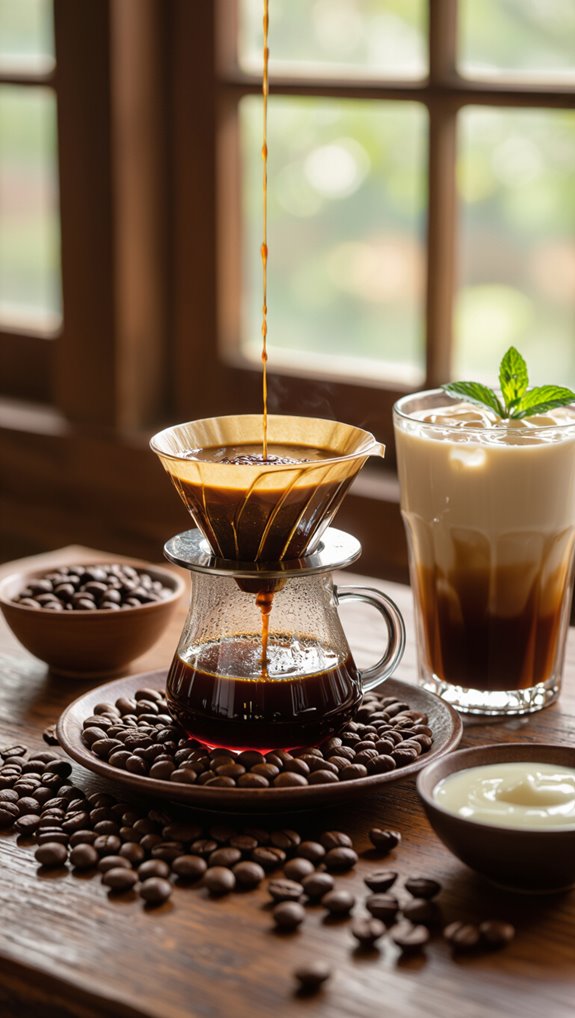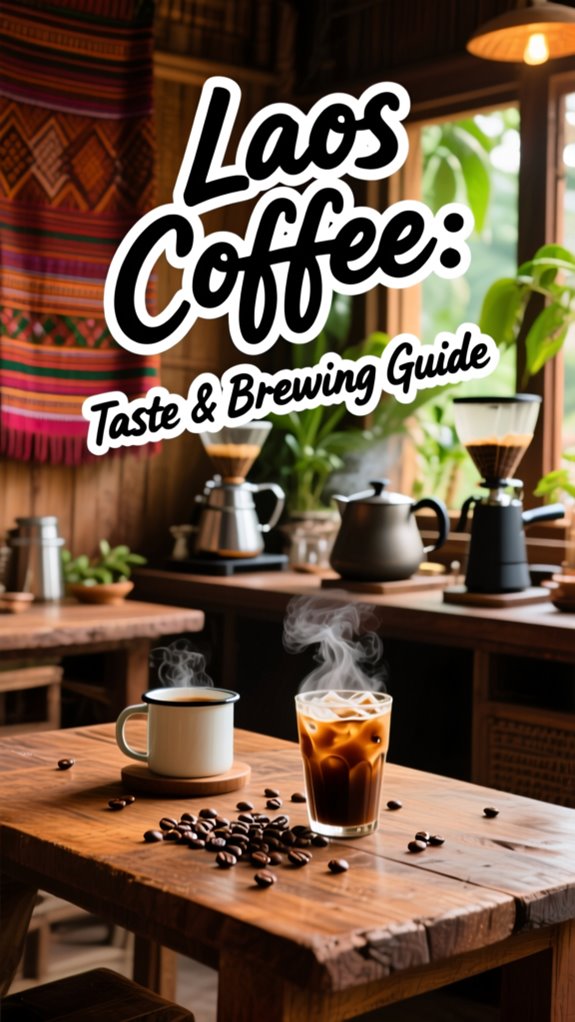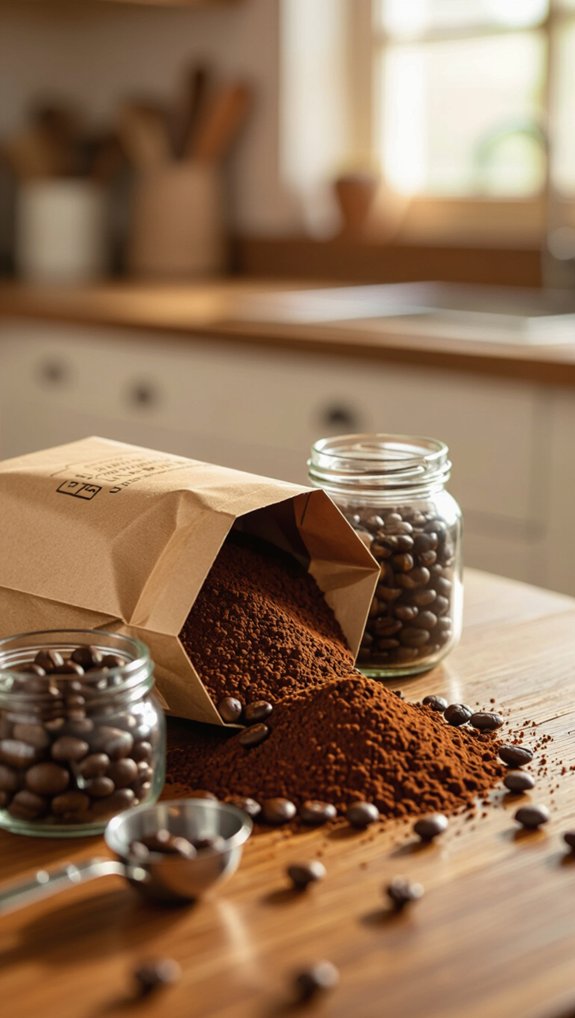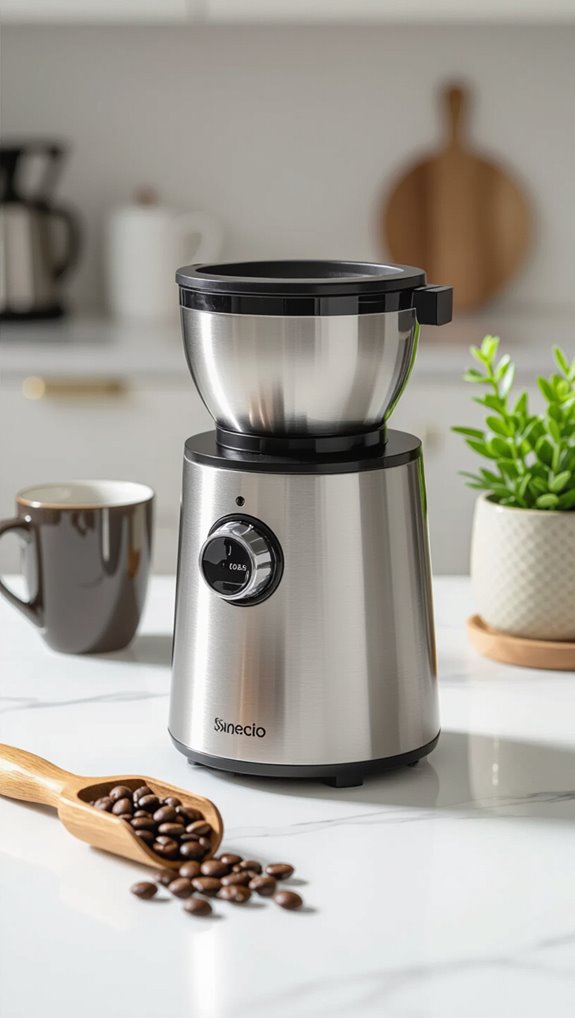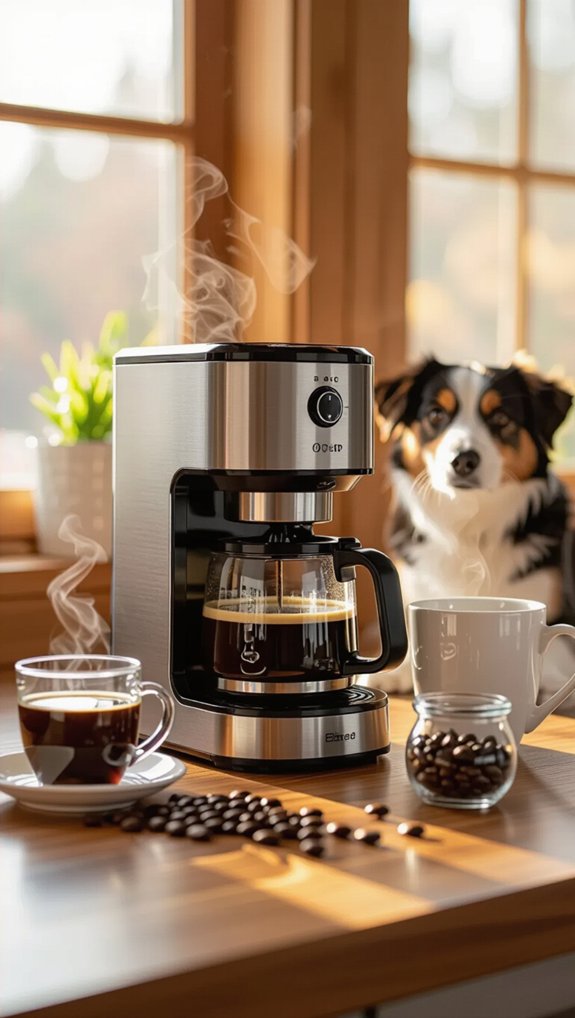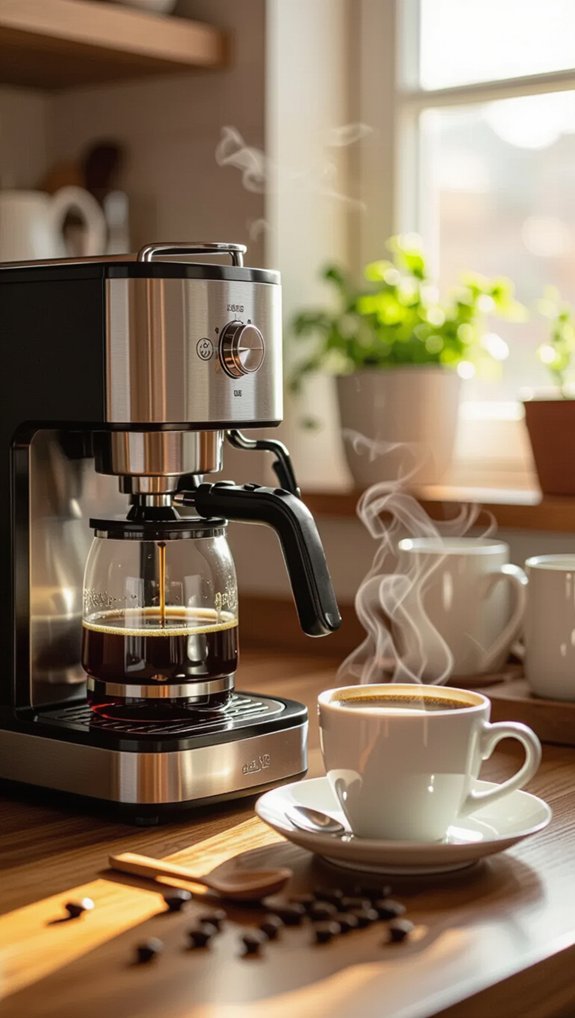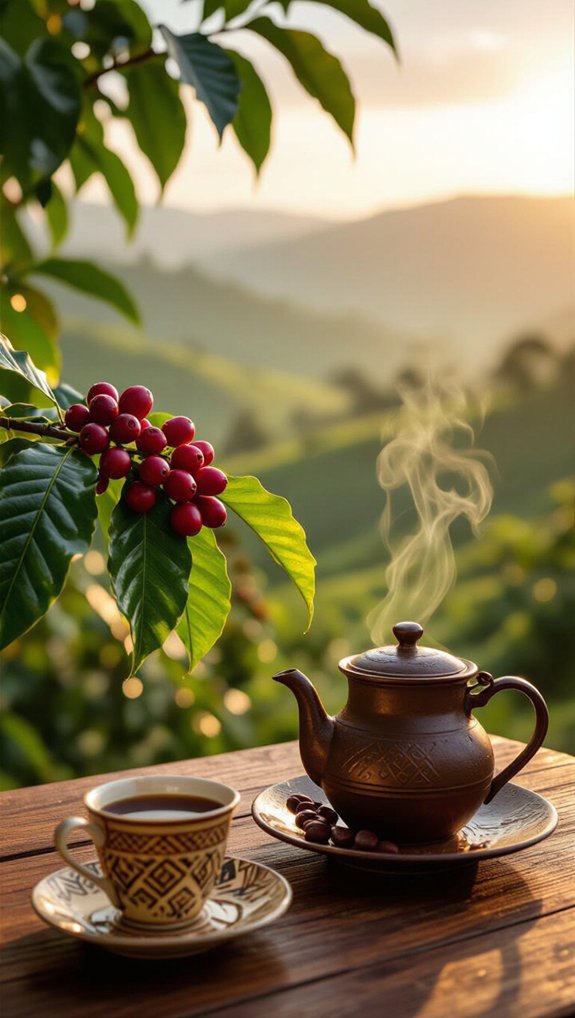Ever wondered why Laos coffee remains one of Southeast Asia’s best-kept secrets? While most coffee enthusiasts gravitate toward beans from Ethiopia or Colombia, they’re missing out on the exceptional flavors emerging from the volcanic soils of the Bolaven Plateau. These high-altitude Arabica beans offer a distinctive syrupy body with rich chocolate undertones that rival any premium coffee on the market.
Despite its outstanding quality, many coffee lovers struggle to find authentic Lao beans or don’t know how to properly brew them to unlock their full potential. This post will guide you through everything you need to know about Laos coffee—from its unique terroir and flavor profiles to step-by-step brewing techniques. You’ll also discover how to create the perfect Lao iced coffee, a refreshing blend that captures the essence of this remarkable coffee culture.
Table of Contents
What does Laos coffee taste like
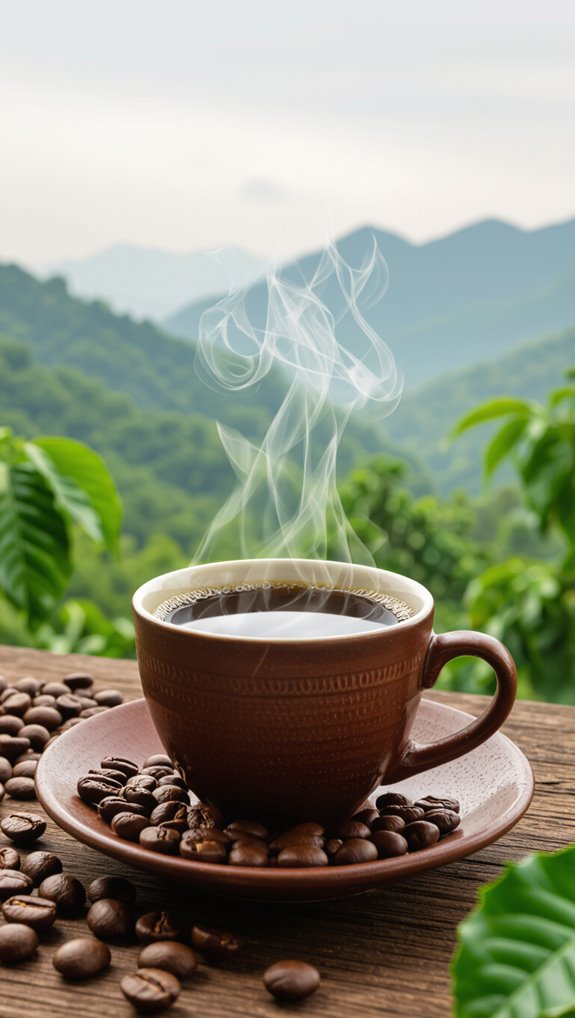
A journey through Laos coffee is like exploring a hidden flavor landscape that delights coffee enthusiasts with its unique taste profile.
On the Bolaven Plateau, Arabica beans offer a smooth, syrupy body with chocolate notes that dance across your palate. Washed processing highlights clean, bright flavors—think baked apple and subtle citrus with delicate floral undertones.
You’ll discover a coffee experience marked by moderate acidity, nutty hints, and a low, balanced bitterness.
Whether enjoying traditional Lao iced coffee or a specialty pourover, each sip reveals the complex, nuanced character of this remarkable origin.
Where is Laos coffee grown mainly
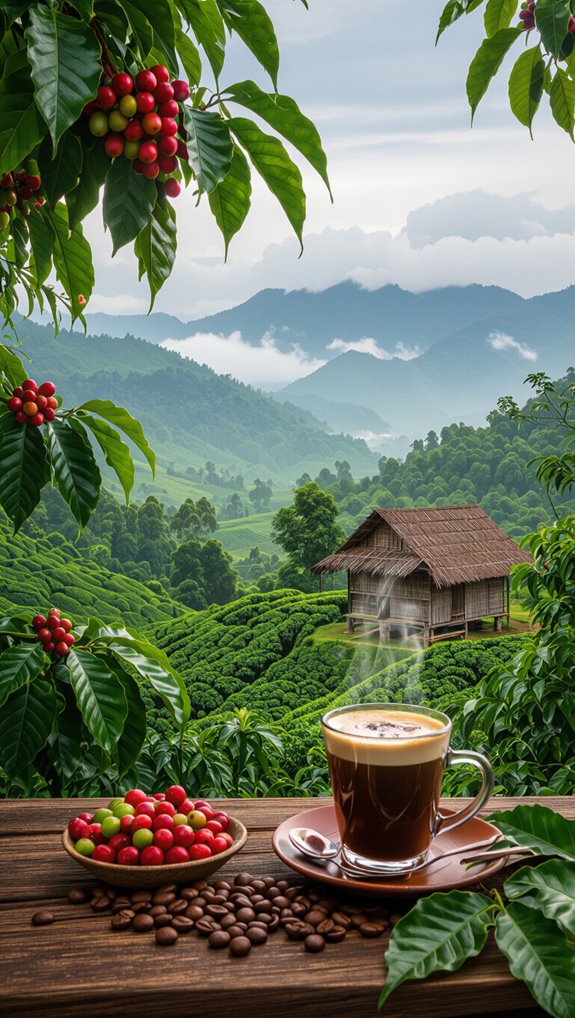
After exploring Laos coffee’s captivating flavor profile, let’s map out where these remarkable beans take root. The Bolaven Plateau dominates Laos’s coffee landscape, accounting for about 95% of national production. Situated between 1,000–1,350 meters above sea level, this volcanic region boasts nutrient-rich soils perfect for Arabica coffee.
Around Paksong and Tad Lo, smallholder farms spanning just one hectare each cultivate coffee across more than 250 villages. These farmers leverage the plateau’s cool temperatures, steady rainfall, and ancient volcanic terrain to produce high-quality beans that define Laos’s coffee reputation.
Laos coffee history and cafe culture
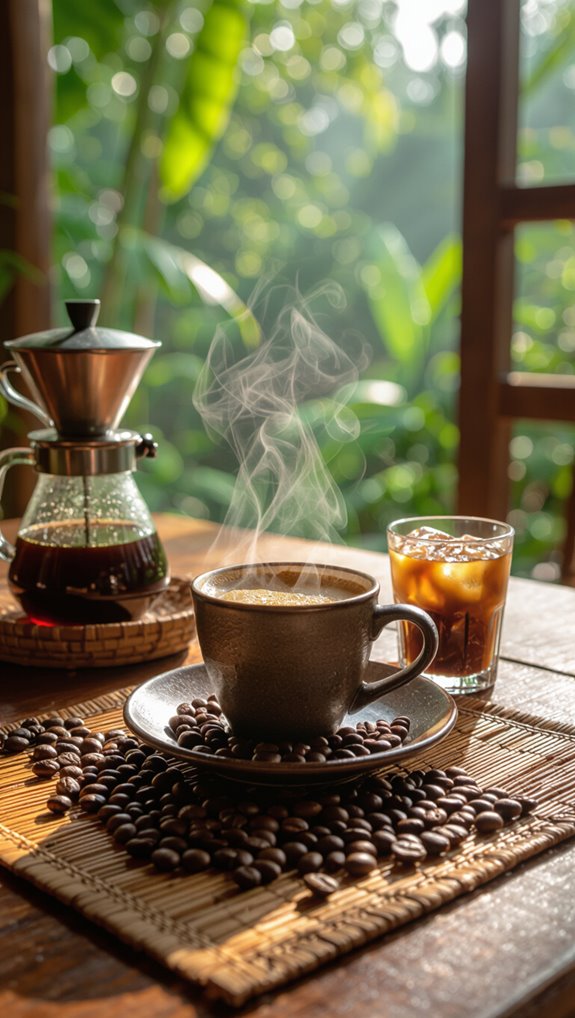
When French colonists arrived in Laos during the early 1900s, they brought more than administrative ambitions—they introduced coffee that would transform the nation’s agricultural landscape. Arabica beans first took root on the Bolaven Plateau, where volcanic soils and ideal climate nurtured exceptional coffee. The Laotian coffee industry evolved through challenges, shifting from traditional Arabica to resilient Robusta, then back to specialty production.
Café Lao emerged as a cultural staple, featuring strong coffee brewed through cloth filters and often served with sweetened condensed milk. Today, urban cafés showcase Laos’s rich coffee heritage, blending traditional techniques with modern brewing styles.
How to make Lao iced coffee
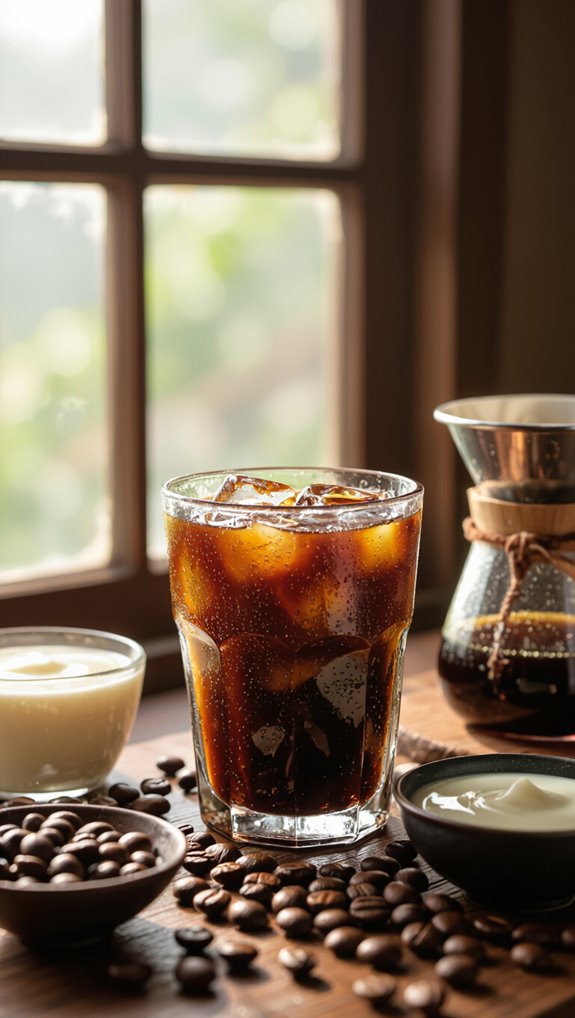
Let me guide you through crafting an authentic Lao iced coffee that’ll transport your taste buds to the Bolaven Plateau. You’ll need just a few key ingredients: dark-roasted coffee beans, sweetened condensed milk, ice, and either a cloth filter or fine metal strainer to create the signature thick, bold concentrate.
I’ll walk you through the simple steps to transform these components into a creamy, sweet, and intensely flavorful iced coffee that captures the essence of Laotian cafe culture.
Ingredients
Dive into the world of Lao iced coffee, and you’ll discover a refreshing brew that beautifully balances strong, dark-roast coffee with sweet, creamy condensed milk. The magic starts with Bolaven Plateau Arabica beans, ground fine and brewed through a traditional cloth filter.
| Ingredient | Amount | Purpose |
|---|---|---|
| Dark Roast Coffee | 25-30g | Strong base |
| Condensed Milk | 15-30ml | Sweetness & Creaminess |
| Ice | 2/3 Glass | Chilling |
| Water/Milk | Remainder | Dilution |
Precise brewing ratios ensure a perfect balance, transforming simple ingredients into a delightful Lao iced coffee experience that’ll transport your taste buds straight to Southeast Asia.
Equipment
After exploring the tantalizing ingredients that make Lao iced coffee a beloved Southeast Asian beverage, it’s time to gear up with the right equipment to brew this refreshing treat.
You’ll need a cloth sock filter (traditional to the Bolaven Plateau), a grinder for your Arabica beans, and a way to measure your brew ratio. A scale helps nail the perfect 1:6–1:10 coffee-to-water ratio.
Don’t forget a tall glass for serving, plenty of ice, and a container for your sweetened condensed milk.
With these tools, you’re ready to craft an authentic iced Lao coffee that’ll transport you straight to Southeast Asia.
Instructions
When you’re ready to craft an authentic Lao iced coffee, you’ll want to gather your ingredients and master the precise brewing technique that makes this Southeast Asian beverage so special. Use finely ground Bolaven coffee and a cloth sock or metal filter to brew a concentrated hot extraction.
| Step | Action | Tip |
|---|---|---|
| 1 | Grind Coffee | Dark roast |
| 2 | Brew Concentrate | 90-95°C water |
| 3 | Sweeten | Condensed milk |
| 4 | Chill | Pack with ice |
Stir in sweetened condensed milk, pour over ice, and enjoy your perfectly crafted Laos iced milk coffee that balances rich, syrupy intensity with creamy sweetness.
Laos coffee bean types and notes
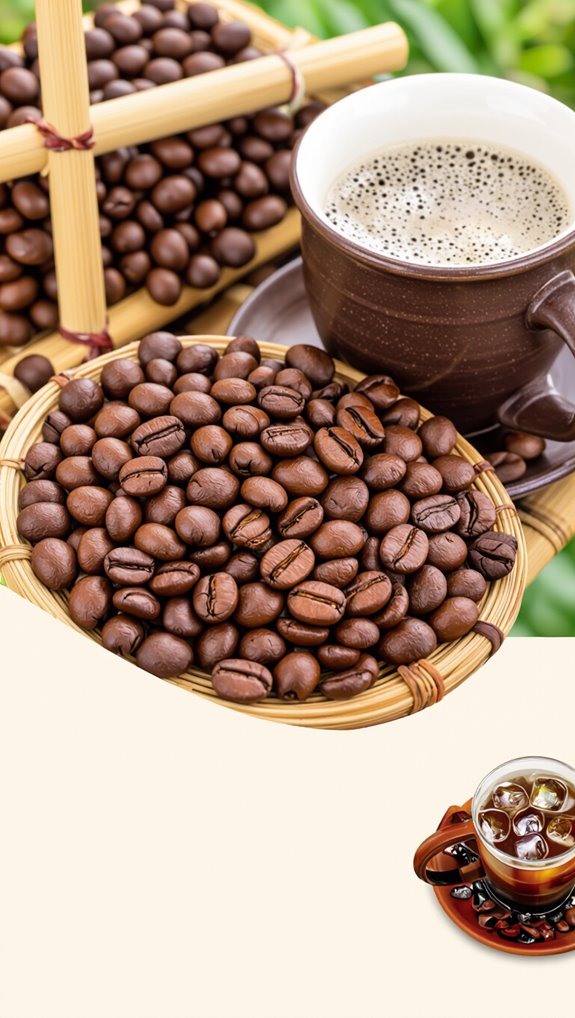
Because Laos has emerged as a hidden gem in the specialty coffee world, coffee lovers are discovering its diverse and nuanced bean varieties. On the Bolaven Plateau, you’ll find remarkable Arabica and Robusta beans with stunning flavor profiles.
The region’s unique processing methods—washed, honey, and sun-dried—dramatically influence each coffee farm’s distinctive taste. Arabica beans offer syrupy, full-bodied cups with chocolate and floral notes, while Robusta delivers complex, earthy flavors with higher caffeine.
From dark espresso blends to lighter specialty micro-lots, Lao coffee presents a remarkable spectrum of taste experiences that’ll intrigue even the most discerning coffee enthusiasts.
Why Bolaven Plateau makes bold beans
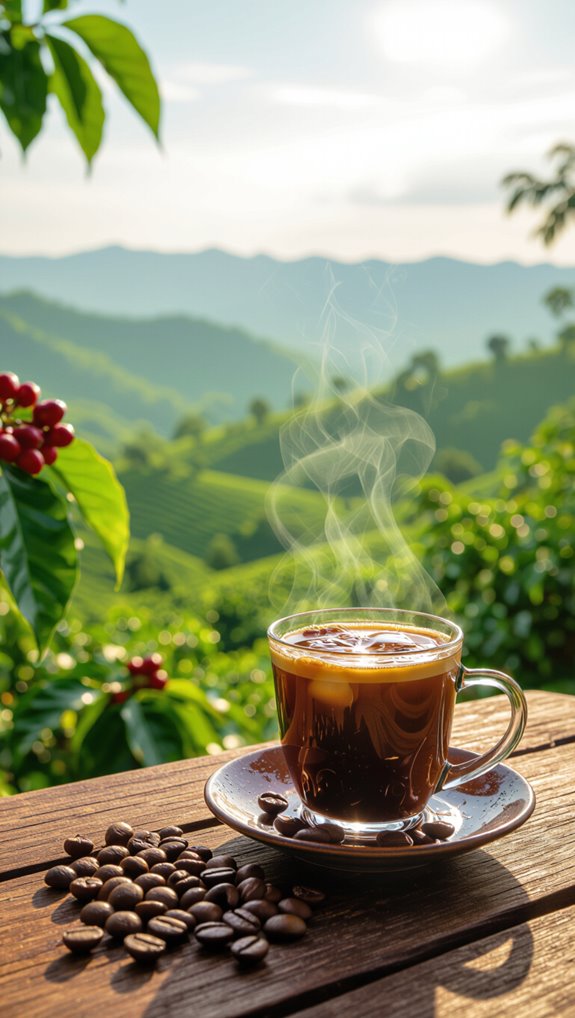
Nestled high in Laos’s southeastern landscape, the Bolaven Plateau transforms coffee cultivation into an art form, creating beans that are nothing short of extraordinary.
Its volcanic soil, rich in minerals, and cool, damp climate at high altitudes nurture both Arabica and Robusta varieties. Smallholder farms meticulously hand-pick cherries, leveraging the plateau’s unique terroir to produce bold, complex flavors.
From syrupy low-acid Arabicas to high-caffeine Robustas, these beans reflect the region’s exceptional growing conditions. The result? A coffee experience that’s as vibrant and distinctive as the Bolaven Plateau itself.
Brewing methods for rich Laos coffee
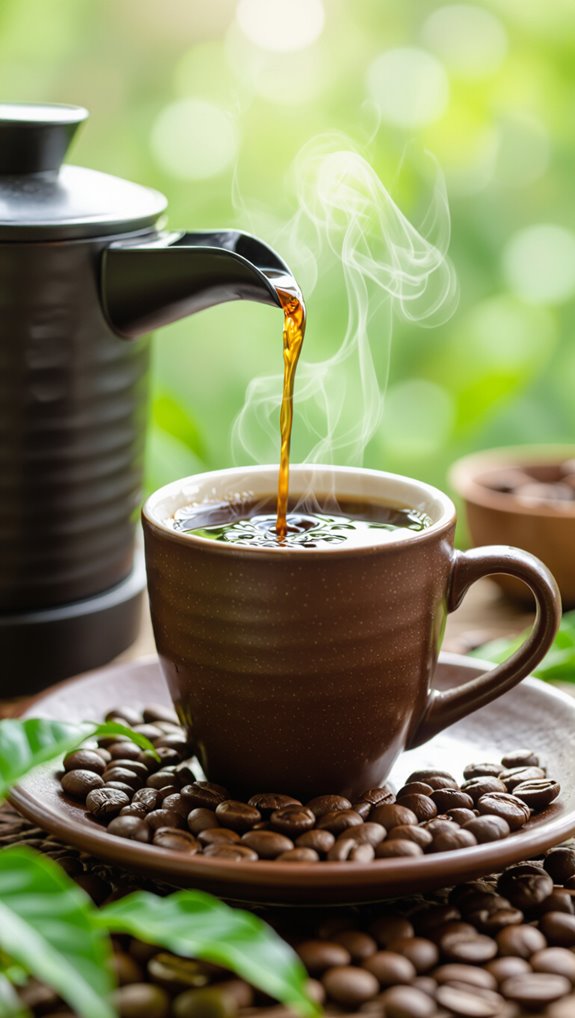
Unlock the rich, complex flavors of Laos coffee through carefully selected brewing methods that highlight the beans’ unique characteristics. Bolaven Arabica demands precision and passion.
Brewing techniques to elevate your Laos coffee experience:
- 🌿 Master the traditional Lao iced brew with a cloth “sock” filter, capturing syrupy chocolate notes
- 🔥 Use precise water temperatures (92–95°C) to extract optimal flavor profiles
- ☕ Experiment with brewing ratios to showcase the coffee’s inherent sweetness and floral nuances
Whether you’re crafting a silky espresso or a vibrant pour-over, each method reveals the incredible depth of Laos coffee’s terroir.
Is Laos coffee worth buying now
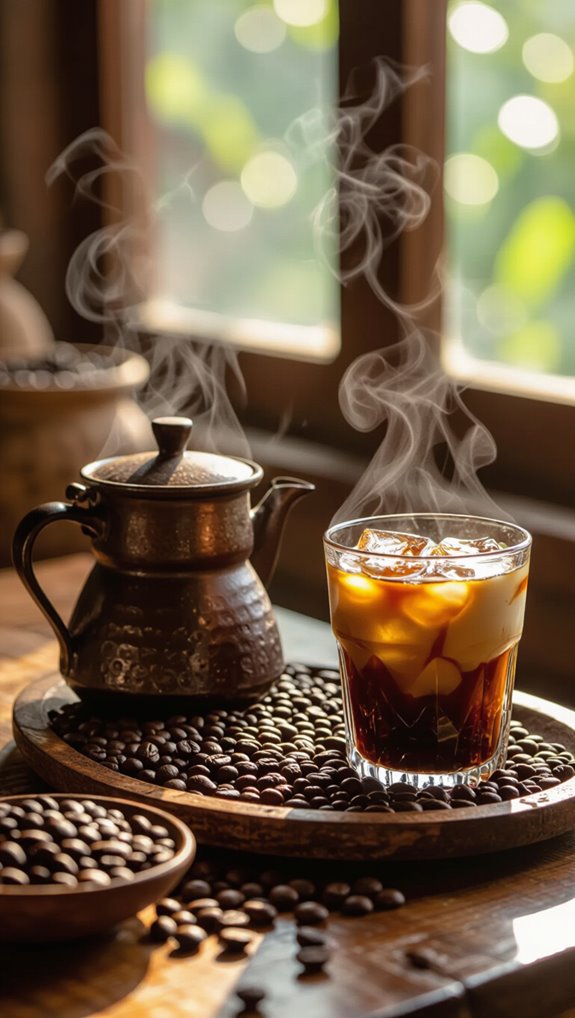
You’ll quickly discover that Laos coffee has transformed from a hidden gem to a compelling specialty origin worth exploring for adventurous coffee enthusiasts.
The Bolaven Plateau‘s volcanic soils produce extraordinary Arabica Bourbon varieties, with Paksong micro-lots offering remarkable complexity.
Honey-processed beans deliver smooth, nuanced flavors that rival more established coffee regions.
The specialty coffee industry’s growing interest means better quality and more accessible options for home brewers.
Whether you’re seeking unique terroir or supporting sustainable farming, Lao coffee provides an exciting alternative to mainstream selections.
I recommend trying a medium-roast single-origin lot to experience this emerging coffee destination’s true potential.
Ethical sourcing and travel tips in Laos
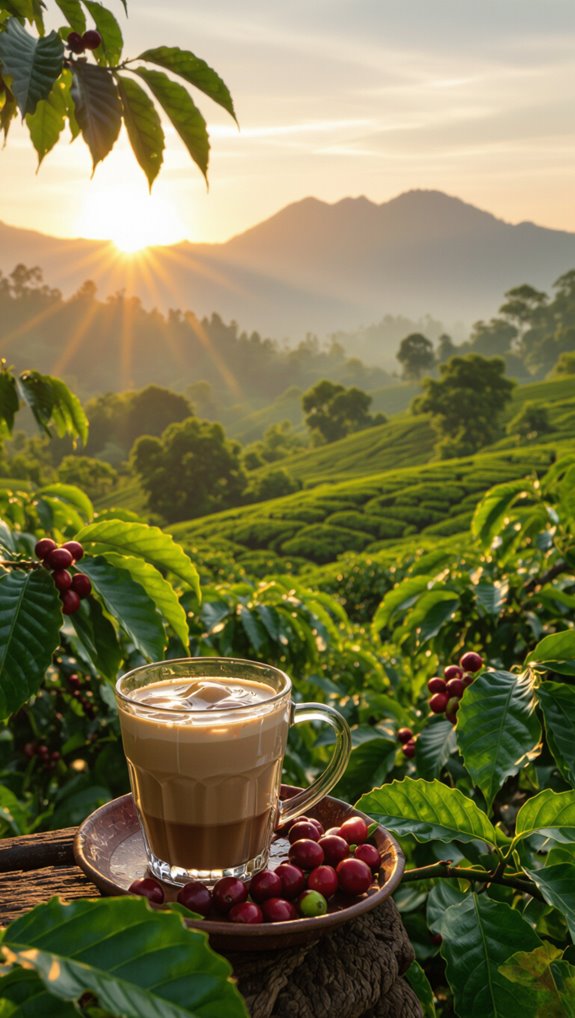
While coffee enthusiasts often seek unique experiences, ethical sourcing in Laos requires careful navigation beyond simple purchasing decisions.
On the Bolaven Plateau, responsible coffee exploration means:
- Prioritize cooperatives and direct-trade micro-lots that ensure farmers receive fair compensation
- Choose organic and Fair Trade certified coffees from regions like Paksong
- Book farm visits through reputable local operators who respect community traditions
When traveling, be mindful of local safety considerations, especially regarding unexploded ordnance.
Budget machines that suit Lao coffee
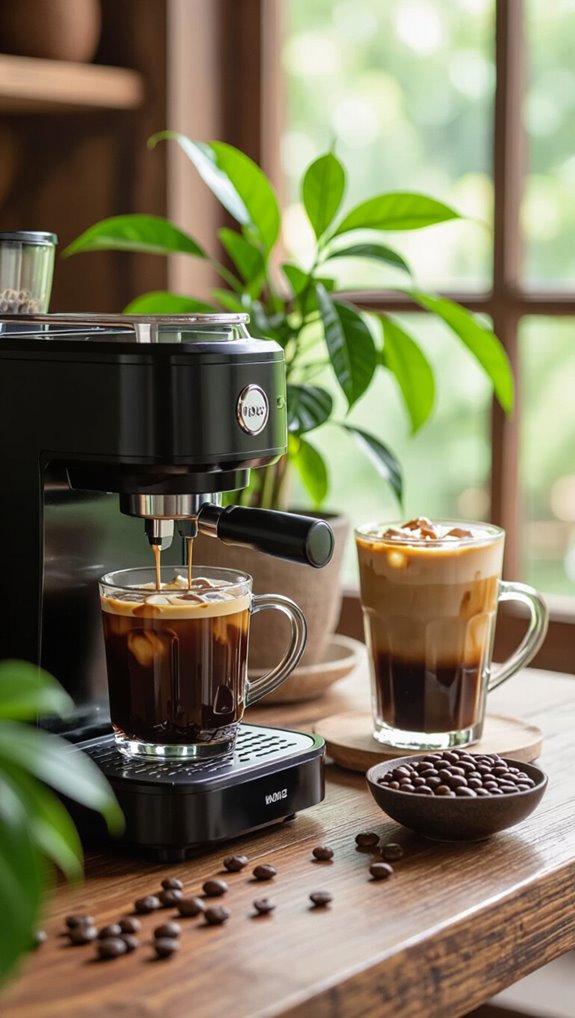
Brewing Lao coffee doesn’t have to break the bank. For budget-conscious coffee lovers, there are affordable options that showcase the rich flavors of Bolaven Arabica. A manual pour-over like V60 highlights the coffee’s chocolate and floral notes for under $25.
Stovetop Moka pots deliver concentrated, syrupy shots perfect for dark roasts, while basic electric drip brewers make strong Café Lao-style brews. Budget automatic espresso machines can pull acceptable shots from Bolaven espresso blends.
Whether you’re exploring coffee farms or brewing at home, these budget-friendly methods ensure you’ll enjoy Laos’s exceptional coffee without emptying your wallet.
Frequently Asked Questions
What Does Laos Coffee Taste Like?
I’ll tell you: Laos coffee offers a smooth, syrupy experience with rich chocolate and caramel notes, bright citrus or apple-like acidity, and a balanced sweetness that’ll delight your taste buds with every sip.
How to Make Laos Coffee?
I’ll brew Lao coffee by using a cloth sock filter or pour-over method with Bolaven Plateau beans, grinding medium-coarse, using a 60 g/kg ratio, and pouring water at 92–96°C to highlight its chocolatey, nutty flavor profile.
Is Laos or Vietnamese Coffee Better?
I prefer Laos coffee for its nuanced, smooth Arabica flavor with chocolate and floral notes, while Vietnam’s Robusta is better if you want strong, bitter, high-caffeine coffee for milky drinks or instant use.
What Is Coffee in Laos Sweetened With?
In Laos, I sweeten coffee with sweetened condensed milk or powdered non-dairy creamer. It’s a local favorite that creates a thick, creamy, and super-sweet drink, often used in both hot and iced coffee preparations.
In Conclusion
Laos coffee truly represents one of Southeast Asia’s best-kept secrets in the specialty coffee world. From the rich volcanic soils of the Bolaven Plateau to the traditional processing methods passed down through generations, Laotian beans offer a distinctive flavor profile that bridges the gap between bold intensity and smooth drinkability. Whether you’re drawn to the chocolatey notes of their dark roasts or the refreshing complexity of traditional Lao iced coffee, this origin delivers an authentic taste experience that’s both accessible and rewarding.
The journey into Laos coffee doesn’t require expensive equipment or complicated techniques – a simple French press or pour-over setup can unlock these beans’ full potential. As you explore this fascinating coffee origin, consider checking out our coffee machine reviews to discover well-tested brewing equipment that can help you make the most of these exceptional beans. With the right tools and quality Laotian coffee, you’ll have everything needed to bring this unique corner of the coffee world into your daily routine.

